-
Posts
1,620 -
Joined
-
Last visited
Content Type
News Articles
Tutorials
Forums
Downloads
Everything posted by mrwonko
-
Animate in some external Tool like Blender, export as ROFF, play using camera ( /*@CAMERA_COMMANDS*/ PATH, "my/roff/file" );
-
/*QUAKED NPC_spawner (1 0 0) (-16 -16 -24) (16 16 40) x x x x DROPTOFLOOR CINEMATIC NOTSOLID STARTINSOLID SHY SAFE DROPTOFLOOR - NPC can be in air, but will spawn on the closest floor surface below it CINEMATIC - Will spawn with no default AI (BS_CINEMATIC) NOTSOLID - Starts not solid STARTINSOLID - Don't try to fix if spawn in solid SHY - Spawner is shy SAFE - Won't spawn if an entity is within 64 units NPC_type - name of NPC (in npcs.cfg) to spawn in targetname - name this NPC goes by for targetting target - NPC will fire this when it spawns it's last NPC (should this be when the last NPC it spawned dies?) target2 - Fired by stasis spawners when they try to spawn while their spawner model is broken target3 - Fired by spawner if they try to spawn and are blocked and have a wait < 0 (removes them) If targeted, will only spawn a NPC when triggered count - how many NPCs to spawn (only if targetted) default = 1 delay - how long to wait to spawn after used wait - if trying to spawn and blocked, how many seconds to wait before trying again (default = 0.5, < 0 = never try again and fire target2) NPC_targetname - NPC's targetname AND script_targetname NPC_target - NPC's target to fire when killed NPC_target2 - NPC's target to fire when knocked out NPC_target4 - NPC's target to fire when killed by friendly fire NPC_type - type of NPC ("Borg" (default), "Xian", etc) health - starting health (default = 100) "noBasicSounds" - set to 1 to prevent loading and usage of basic sounds (pain, death, etc) "noCombatSounds" - set to 1 to prevent loading and usage of combat sounds (anger, victory, etc.) "noExtraSounds" - set to 1 to prevent loading and usage of "extra" sounds (chasing the enemy - detecting them, flanking them... also jedi combat sounds) spawnscript - default script to run once spawned (none by default) usescript - default script to run when used (none by default) awakescript - default script to run once awoken (none by default) angerscript - default script to run once angered (none by default) painscript - default script to run when hit (none by default) fleescript - default script to run when hit and below 50% health (none by default) deathscript - default script to run when killed (none by default) These strings can be used to activate behaviors instead of scripts - these are checked first and so no scripts should be names with these names: default - 0: whatever idle - 1: Stand around, do abolutely nothing roam - 2: Roam around, collect stuff walk - 3: Crouch-Walk toward their goals run - 4: Run toward their goals standshoot - 5: Stay in one spot and shoot- duck when neccesary standguard - 6: Wait around for an enemy patrol - 7: Follow a path, looking for enemies huntkill - 8: Track down enemies and kill them evade - 9: Run from enemies evadeshoot - 10: Run from enemies, shoot them if they hit you runshoot - 11: Run to your goal and shoot enemy when possible defend - 12: Defend an entity or spot? snipe - 13: Stay hidden, shoot enemy only when have perfect shot and back turned combat - 14: Attack, evade, use cover, move about, etc. Full combat AI - id NPC code medic - 15: Go for lowest health buddy, hide and heal him. takecover - 16: Find nearest cover from enemies getammo - 17: Go get some ammo advancefight - 18: Go somewhere and fight along the way face - 19: turn until facing desired angles wait - 20: do nothing formation - 21: Maintain a formation crouch - 22: Crouch-walk toward their goals delay - after spawned or triggered, how many seconds to wait to spawn the NPC */ In short, place an NPC_Spawner and set its NPC_Type to the name of your NPC.
-
Use an npc_spawner.
-
Not with icarus. You can just link the spawnpoint to the vehicle entity using target/targetname like you'd link a trigger to a door. You may have to set the vehicle's count to -1 to get it to respawn.
-
No, I'm talking about the angle. If its 90, make it 270, so it moves in the opposite direction.
-
This happens because the lighting is pre-calculated into a so-called lightmap when you compile the map. There is (practically) no dynamic lighting. So you'll have to choose which light you want for your door. If you'd prefer to have the light in its final location, move it there in Radiant, reverse its direction and set it to start open.
-
One texture & UV map and 1000 vertices per mesh.
-
Why do you need to work with Steam JKA? Why won't a different one do?
-
Well the problem is that there is no debugging information for jamp.exe since the Binary was not built with debug information. So build your own jamp.exe with debug information. What are you trying to achieve?
-
None of those statements are true.
-
Evidently not or they would've posted.
-
A question: Is it so hard to use a more useful title than "A question:"? Sabers are coded to work like they do, so outside of a custom mod what you're asking for isn't possible.
-
I did tell you to RTFM.
-
I highly doubt this, it should be technically impossible. You could try my Blender Plugin Suite, it has an ASE importer and an MD3 exporter. Just make sure to read the manual to find out how to properly set the textures for MD3 export. https://jkhub.org/files/file/1413-blender-264-jedi-academy-plugin-suite/
-
Where is the "I don't care about MP at all anymore" option? Alternatively, where's "no saber, no force"?
-
Please don't use a meaningless title like help.
-
Right, I didn't think about the alpha map and how it's mapped to the terrain... yeah, changing its dimensions when deleting brushes is probably a bad idea. I have no idea which version of EasyGen I used, it's whatever was once available at http://wolfenstein-city.4players.de/dlman/download.php?id=276 - which is now a dead link. I don't know about the raised brushes... They don't have any special shader compared to the rest and they're not part of some entity that may move them, right? (Well that would be crazy...) Must be some kind of glitch then, the question is where from.
-
It may be easier to do the removal of the unwanted parts in Radiant since you can select stuff inside or touching a brush there. Not sure about the textures, been ages since I used easygen... I think it may have been a matter of using the right shader templates, may have been something with Q3Map2 or Ydnar in its name? I seem to not have easygen installed anymore so I can't check. That is, if you want to use multi-texturing. If you just want 1 texture across the whole terrain it's just a matter of setting it during export, and if you did that it's probably one of the typical texture problems - not running sv_pure 0 in mp (and texture not in a .pk3), invalid texture size, unsupported texture format (like progressive jpegs) or incorrect compression on pk3 files. As for weirdly positioned brushes, see if there's an option to align the map to the grid at export and do a brush cleanup in radiant.
-
You may not have a proper system.shader with a skip shader. Does the skip texture in the texture browser have the outline that shaders like areaportal have? (Or can you shift-click it to open its shader?) Actually, this should be easy to spot ingame as well. If you approach the door from the other direction, is there a brush with skip written on it visible inside the door? Unless only Q3Map2 can't find the shader due to being incorrectly set up, but JKA finds it...
-

GTK Radiant 1.5 will no compile .map to make it .bsp
mrwonko replied to Merek's topic in Modding Assistance
I suggest using 1.6, which is based on 1.4, not 1.5, and has a couple of nice fixes like being able to save new maps in Windows 7. -
/*QUAKED NPC_Vehicle (1 0 0) (-16 -16 -24) (16 16 32) NO_PILOT_DIE SUSPENDED x x DROPTOFLOOR CINEMATIC NOTSOLID STARTINSOLID SHY NO_PILOT_DIE - die after certain amount of time of not having a pilot SUSPENDED - Fighters: Don't drop until someone gets in it (this only works as long as no-nw has *ever* ridden the vehicle, to simulate ships that are suspended-docked) - note: ships inside trigger_spaces do not drop when unoccupied CINEMATIC - Will spawn with no default AI (BS_CINEMATIC) NOTSOLID - Starts not solid STARTINSOLID - Don't try to fix if spawn in solid SHY - Spawner is shy set NPC_type to vehicle name in vehicles.dat "dropTime" use with SUSPENDED - if set, the vehicle will drop straight down for this number of seconds before flying forward "dmg" use with NO_PILOT_DIE - delay in milliseconds for ship to explode if no pilot (default 10000) "speed" use with NO_PILOT_DIE - distance for pilot to get away from ship after dismounting before it starts counting down the death timer "model2" - if the vehicle can have a droid (has "*droidunit" tag), this NPC will be spawned and placed there - note: game will automatically use the one specified in the .veh file (if any) or, absent that, it will use an R2D2 or R5D2 NPC) showhealth - set to 1 to show health bar on this entity when crosshair is over it teamowner - crosshair shows green for this team, red for opposite team 0 - none 1 - red 2 - blue teamuser - only this team can use this NPC 0 - none 1 - red 2 - blue teamnodmg - team that NPC does not take damage from (turrets and other auto-defenses that have "alliedTeam" set to this team won't target this NPC) 0 - none 1 - red 2 - blue */Just read the description in Radiant? You set npc_type to the name as defined in the ext_data/vehicles/*.veh files.
-

Invisible parts on advanced shapes - Mapping
mrwonko replied to Fire Phoenix's topic in Modding Assistance
Don't you ever use brushes for round stuff! That's what patches are there for. -

Invisible parts on advanced shapes - Mapping
mrwonko replied to Fire Phoenix's topic in Modding Assistance
That texture makes it pretty hard to see what shape that thing has... I suppose it's a cylinder? How did you create it? -
YAY! ALL CAPS TITLES! EXCLAMATION MARKS!
-

Texture tilation when running and testing a custom map.
mrwonko replied to ZeroRaven's topic in Modding Assistance
default_scale is for the editor. Okay, then you may have to adjust the paths in scripts/user*.proj...



